#Cecil Andrus
Text
Idaho Governor DILFs






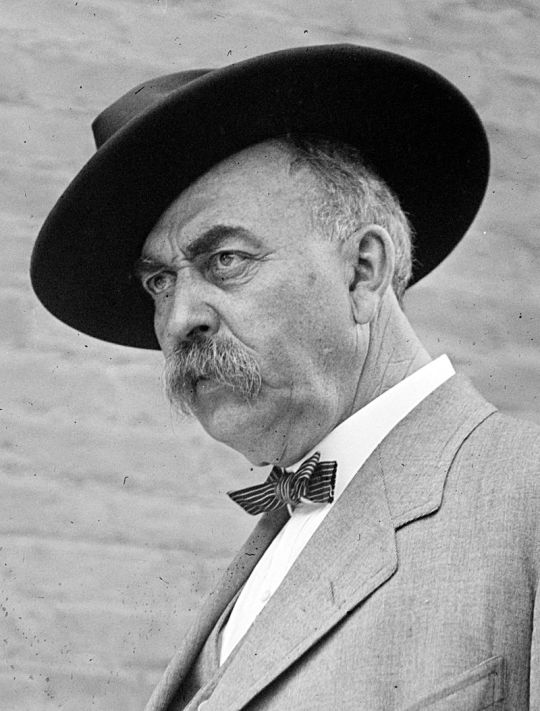

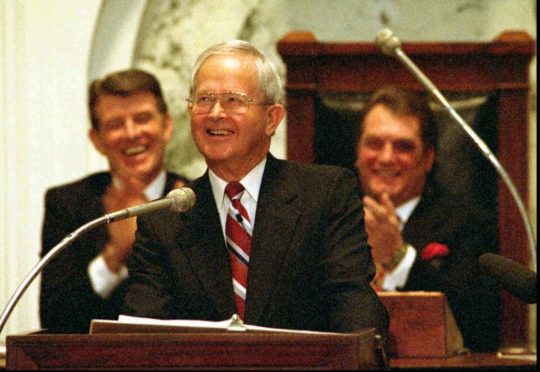




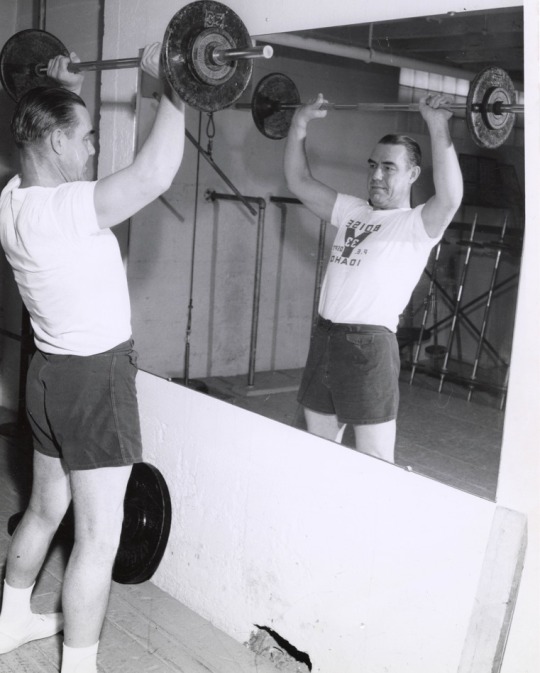
Brad Little, Chase A. Clark, Butch Otter, Cecil Andrus, Arnold Williams, Jim Risch, James H. Hawley, Frank R. Gooding, Phil Batt, Dirk Kempthorne, Don Samuelson, John Evans, Leonard B. Jordan, Robert E. Smylie
#Brad Little#Chase A. Clark#Butch Otter#Cecil Andrus#Arnold Williams#Jim Risch#James H. Hawley#Frank R. Gooding#Phil Batt#Dirk Kempthorne#Don Samuelson#John Evans#Leonard B. Jordan#Robert E. Smylie#GovernorDILFs
9 notes
·
View notes
Text
In Idaho in 1990, one of the nation's most restrictive abortion bills was vetoed by Cecil Andrus, the state's "pro-life" governor—after pro-choice women declared a boycott of Idaho potatoes. Some feminist leaders argued against such forceful tactics. "Let the governor make his decision based on the seriousness of this issue and the Constitution, not potatoes," National Abortion Rights Action League's executive director Kate Michelman advised. But it was the boycott that clinched it. "Anytime someone threatens one of our major cash crops," Governor Andrus explained, "it becomes significant."
-Susan Faludi, Backlash: the Undeclared War Against American Women
333 notes
·
View notes
Note
Who were some of the other "Future Leaders" in that Time piece, and did they go anywhere?
Yes, there were: Lamar Alexander (33 years old at the time); Les Aspin (35); Kit Bond (35); Julian Bond (34); Bill Bradley (30); Jerry Brown (36); Willie Brown (40); Pat Buchanan (35); William Cohen (33); Morris Dees (36); Ron Dellums (38); Marian Wright Edelman (35); Elizabeth Hanford aka Elizabeth Dole (37); Richard Holbrooke (33); Maynard Jackson (36); Barbara Jordan (38); Vernon Jordan (38); Doris Kearns aka Doris Kearns Goodwin (31); Jack Kemp (38); John Lewis (34); Eleanor Holmes Norton (37); Sam Nunn (35); Ross Perot (44); Jay Rockefeller (37); Carl Sagan (39); Lowell Weicker (43); Andrew Young (42). There were more -- it was a list of 200 future leaders, so they took a lot of shots at the hoop.
They also kind of cheated because there were also a bunch of "Future Leaders" who were already leaders like Ted Kennedy, Cecil Andrus, Ralph Nader, Lawton Chilres, Joan Ganz Cooney, Charles Rangel, Billie Jean King, Donald Rumsfeld, Bill Russell, and Gloria Steinem.
It's the July 15, 1974 issue of TIME if you're interested.
4 notes
·
View notes
Text
A record of Morrison Center Boise Idaho
Morrison Middle can be a carrying out disciplines place in Boise, Idaho. It will be the property from the Idaho Opera, Idaho Shakespeare Festivity, and Boise Philharmonic. Morrison Center is also house to the School of Idaho's executing arts applications. The middle established in 1984 which is called after past Idaho governor Cecil Andrus.
Morrison Heart for that Undertaking Artistry is situated on the university from the School of Idaho in the downtown area Boise. The heart was developed at a cost of $8 million and is adjacent to the Boise Stream Greenbelt. The heart features a 2,037-seating auditorium, a 1,200-seating live theatre, along with a 400-seat black color container live theatre. The center also has rehearsal and class room place, getting dressed spaces, and workplaces.
The auditorium is commonly used for opera, ballet, and orchestral performances. The theatre is used for takes on, musicals, along with other performances. The black pack theatre can be used for experimental and university student shows. Morrison Center also hosts a variety of events like conventions, lectures, and classes.
Morrison Middle Performing Artistry Boise Idaho is the home of the Idaho Opera. The opera firm was founded in 1977 which is the state's only professional opera organization. The corporation produces two operas each season. The Idaho Shakespeare Festivity can also be dependent at Morrison Center. The festivity creates four has each summertime. The Boise Philharmonic may be the center's resident orchestra. The orchestra does five concerts each period.
The School of Idaho's performing disciplines programs can also be dependent at Boise State Morrison Center. The courses are the Idaho Repertory Live theatre and also the Idaho Summer season Repertory Live theatre. The Idaho Repertory Theatre creates six performs each time of year. The Idaho Summertime Repertory Theatre creates three takes on each summertime.
Morrison Heart for the Carrying out Artshas been the website of numerous renowned performances. These have included the planet premieres of operas by Philip Cup and Jonathan Dove, as well as the US premiere of the opera The Merry Widow. Morrison Center has additionally hosted various world-recognized performers for example Yo-Yo Ma, Itzhak Perlman, as well as the Moscow State Symphony Orchestra.
Morrison Middle tickets cost
The Morrison Center for the Performing Arts is probably the most popular undertaking artistry sites in america. Tickets to discover a display at the Morrison Center could be very pricey, but the encounter is without a doubt well worth the selling price. The acoustics with the Morrison Center for the Performing Arts are outstanding, and the area is absolutely stunning. If you have the possibility to notice a display on the Morrison Center, will not be reluctant to acquire a solution - it will likely be an event you are going to always remember.
Morrison Center Performing Arts Boise Idaho is the home of the Idaho Opera Click here for more information kindly visit the site at boisetheatercenter.com/ to get the knowledge about morrison center.
1 note
·
View note
Photo

Cecil Andrus, from the Wood River Journal photo archive, both circa 1975.
Former Governor Cecil Andrus passed away last week at the age of 85. Idaho's only four term governor, Andrus also served as Jimmy Carter's Secretary of the Interior. Andrus is perhaps best remembered as a conservationist and a key figure in the establishment of the Sawtooth National Recreation Area and later the Boulder-White Clouds wilderness.
#Cecil Andrus#Idaho#Idaho politics#wood river journal#ketchum#bald mountain#baldy#governor#politics#politicians#democrats#conservationists
15 notes
·
View notes
Text
Cecil Andrus, Idaho icon, dies at 85 - Fri, 25 Aug 2017 PST
Cecil Andrus, Idaho’s longest-serving governor, former U.S. Secretary of the Interior, Democrat and champion of wilderness and the Idaho outdoors, died late Thursday after a battle with cancer, the night before his 86th birthday.
Cecil Andrus, Idaho icon, dies at 85 - Fri, 25 Aug 2017 PST
0 notes
Text
Political Change in Boise
Dave Bieter leaves office having turned Boise blue. When elected mayor in 2003, in Boise’s five legislative districts six of fifteen seats in the Idaho Legislature were held by Democrats. Today it’s fourteen of fifteen seats. Democrats also now hold a majority of the Ada County Commission for the first time since 1977-78.
Among current public officials, Dave represents the last real tie to the Frank Church and Cecil Andrus eras: home-grown Democrats in a historically Republican-dominated town that was Boise. Church, then Andrus, were both able to construct a majority vote in their races by appealing to independents and moderate Republicans. Winning Boise, they could prevail statewide with hefty margins in Democratic North Idaho and Pocatello. But no Democratic candidate for Boise mayor (though officially a nonpartisan race) had been able to break through since the Depression. Dave was the first.
As a youngster Dave remembers tossing the football at the Basque picnic with these leaders. His dad Pat chaired the Citizens for Church committee in 1968 and connected Frank and Cece to the Basque community. His mom Eloise Garmendia was part of the core of Democrats in this town that included Basques, Catholics, government workers and blue collar laborers. She worked for Calvin Wright, a former statewide office holder and Democratic nominee for Governor, and confidant of Church and Andrus. The relationship across generations meant when the time would come the kid catching the spiral pass was out there in 1986 pounding signs for Andrus, big 4’ by 8’ plywood billboards from Boise to Banks.

Two years after Andrus left office Pat Bieter would be elected to the State House of Representatives. Dave was appointed to the position after Pat and Eloise died in an automobile accident in 1999, then won his own elections in 2000 and 2002 in the only Democratic legislative district at that time.
A generation after Church’s last race and 13 years after Andrus’ Dave stunned the experts with a 52% majority in a four way race for mayor in 2003 in what was still considered a Republican city. To get there Dave secured the endorsement of Cecil Andrus at his campaign announcement. Bethine Church came on board after telling Dave, “Let’s see how you do” in his initial campaigning first.
Once elected, Dave accelerated the political trend in Boise towards Democratic dominance. His campaign organization harnessed in the remarkable 2003 win was later replicated to expand Democratic seats in the Legislature in 2004 and 2006, and later helped establish College of Western Idaho by popular vote, a campaign that coordinated efforts with GOP Governor Butch Otter. Additional levy votes for the foothills and the Boise River passed by overwhelming margins.
Re-elections as mayor were largely a cakewalk as the Democratic vote totals grew lopsided across the city. When Bethine was asked to make a campaign contribution she did one better by opening the doors to her large townhouse on Walnut Street, inviting Church loyalists to support Dave’s campaign.
Having carried forward the Church/Andrus legacies in Boise it’s both symbolic and meaningful that there is now a Bethine Church Boise River trail and a Cecil D. Andrus Park in Boise. Both were named as such by Dave.
Longevity and success can often help determine ultimate political fate. So when Dave ran for a fifth term he faced an electorate that has become larger in number and strongly Democratic in voting. At the same time, the Church and Andrus legacies have faded. Bethine Church passed in 2014 and Cecil Andrus in 2017, so neither were around to repeat an endorsement. Besides, an ever increasing proportion of the Boise electorate were not here the last time either Church (1980) or Andrus (1990) were on the ballot. Even memories fade of Dave’s unexpected majority in a four way race in 2003. Over time, the city and political trend he has much to do with building and expanding, has moved on. And in fact it’s grown so large it overwhelmed him as the newer voters in Boise have taken hold. Certainly not what he wanted at this time, but a pretty good legacy nonetheless!
1 note
·
View note
Text
Insulting Andrus: Risch’s temper tantrum lets us peek behind the curtain of Idaho politics | Idaho Statesman
Insulting Andrus: Risch’s temper tantrum lets us peek behind the curtain of Idaho politics | Idaho Statesman
Author: Idaho Statesman Editorial Board / Source: idahostatesman It would be easy to simply view the dustup over the bill naming the 2015 central Idaho wilderness for former Gov. Cecil Andrus as simply the petty and embarrassing episode that it is. But that would miss several potential lessons, the ripple effects of which cannot be known today. The first should not be overlooked. Creating the…
View On WordPress
0 notes
Photo
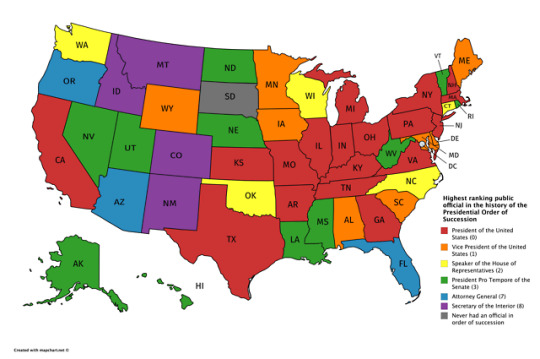
Map of US states showing the highest ranking public official in the history of the Presidential Order of Succession
PopsicleIncorporated:
Here's a list of the first person to reach the highest office from each state.
President
AR - Bill Clinton (1993)
CA - Herbert Hoover (1929)
GA - Jimmy Carter (1977)
IL - Abraham Lincoln (1861)
IN - Benjamin Harrison (1889)
KS - Dwight Eisenhower (1953)
KY - Zachary Taylor (1849)
MA - John Adams (1797)
MI - Gerald Ford (1974)
MO - Harry Truman (1945)
NH - Franklin Pierce (1853)
NJ - Woodrow Wilson (1913)
NY - Martin van Buren (1837)
OH - William Harrison (1841)
PA - James Buchanan (1857)
TN - Andrew Jackson (1829)
TX - Lyndon Johnson (1963)
VA - George Washington (1789)
Vice President
AL - William King (1853)
DE - Joe Biden (2009)
IA - Henry Wallace (1941)
ME - Hannibal Hamlin (1861)
MD - Spiro Agnew (1969)
MN - Hubert Humphrey (1965)
SC - John C. Calhoun (1825)
WY - Dick Cheney (2001)
Speaker of the House
CT - Jonathan Trumbull (1791)
OK - Carl Albert (1971)
NC - Nathaniel Macon (1801)
WA - Tom Foley (1989)
WI - Paul Ryan (2015)
President Pro Tempore
AK - Ted Stevens (2003)
HI - Daniel Inhouye (2010)
LA - Allen Ellender (1972)
MS - George Poindexter (1834)
NE - Charles Manderson (1891)
NV - Key Pittman (1933)
ND - Milton Young (1980)
RI - William Bradford (1797)
UT - Orrin Hatch (2015)
VT - Stephen Bradley (1802)
WV - Robert Byrd (1989)
Attorney General
AZ - Richard Kleindienst (1972)
FL - Janet Reno (1993)
OR - George Williams (1871)
Secretary of the Interior
CO - Henry Teller (1882)
ID - Cecil Andrus (1977)
MT - Ryan Zinke (2017)
NM - Albert Fall (1921)
South Dakota has had an official appear in the order of succession.
145 notes
·
View notes
Photo
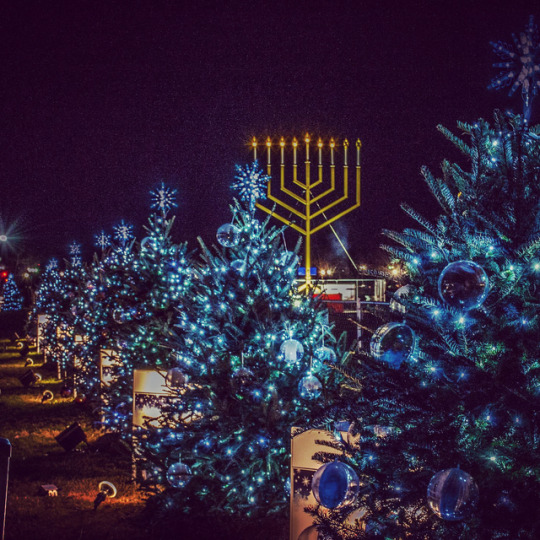
The National Menorah is a large hanukkah menorah located in the northeast quadrant of The Ellipse near the White House in Washington, D.C. It was first lit in 1979 by President Jimmy Carter, and has been erected and lit every year since. The Menorah has grown in size as well, and is now 30 feet high.⠀ ⠀ 📍: President's Park/White House, Washington DC⠀ 📅 : December 2016⠀ ⠀ #nps #travel #explore #learn #nationalparkgeek #washingtondc #holidays⠀ History:⠀ ⠀ In 1974 Rabbi Menachem M. Schneerson called for the public awareness of the festival of Hanukkah and encouraged the lighting of public menorahs. Although initially criticized by liberal Jewish organizations, Schneerson defended the campaign. In 1979, Abraham Shemtov of Chabad, sought to erect a menorah on the White House lawn. Cecil D. Andrus, the secretary of interior initially denied Shemtov a permit to put a menorah on government property, saying it would violate the First Amendment. Stuart E. Eizenstat eventually settled the matter and a permit was granted.⠀ ⠀ That year, President Jimmy Carter ended 100 days of self-imposed seclusion over the Iran hostage crisis by walking to Lafayette Park, and lighting the Menorah erected there by Chabad. Carter delivered brief remarks. Every president since has recognized Hanukkah with a special menorah-lighting.⠀ ⠀ President Ronald Reagan is credited with naming it the National Menorah in a statement read during the menorah-lighting in Lafayette Park in 1982.⠀ ⠀ As of 2013, the Menorah was 30 feet high, and rested on an elevated platform 2 feet high. The height of the hanukiah and platform are regulated by rabbinical law, which requires the menorah to be both visible (minimum height off the ground) and of a maximum height (a person must look upward but not uncomfortably so). (wikipedia)⠀ (at President's Park (White House))
2 notes
·
View notes
Text
Where to go for New Year's Eve <b>events</b> in the Treasure Valley
This is Idaho's signature holiday event! It is FREE and there will be events in Cecil D. Andrus Park featuring music, sports and live art performances.
from Google Alert - event https://ift.tt/2MHMb8F
0 notes
Photo
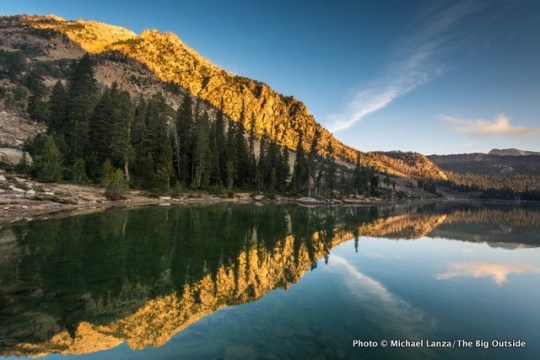
Dawn at Quiet Lake in Idaho’s Cecil D. Andrus-White Clouds Wilderness, created in 2015.
By Michael Lanza
How’s it feel to be a conservationist in America today? Does it feel like people who want the government to protect the environment—which is a large majority of Americans—suddenly find themselves losing a war that it seemed we had already won?
These are strange and frustrating times for conservation. We have to wonder: How could so many Americans believe that climate science is bogus—or even a “hoax,” as a certain world leader calls it? How could so many of our countrymen and women applaud as the current White House takes an axe to the agency created four decades ago to protect the very environment we live in? Or buy into the corrupt notion that ceding control of our prized public lands to private interests could, in any way, be in our public interest?
And where do we go from here?
Somewhere along the line, logic got turned on its head. We need to stand it upright again—and we can.
The Bears Ears buttes in Bears Ears National Monument, which President Trump shrank by 85 percent.
The good news is that while we are, in many ways, mired in a war for the future not only of conservation but for the nation’s values—not to mention human civilization—environmentalists do have a much larger army than the opposition. Gallup reported in March 2018 that “62 percent of Americans say government is doing too little on the environment,” the highest that number has been since 2006.
The same poll found overwhelming majorities want more public investment in renewable energy, higher pollution and auto-emissions standards, and stronger enforcement of environmental regulations. Seven in 10 Americans believe climate change is happening and six in 10 want the government to do something about it.
Hi, I’m Michael Lanza, creator of The Big Outside, which has made several top outdoors blog lists. Click here to sign up for my FREE email newsletter. Subscribe now to get full access to all of my blog’s stories. Click here to learn how I can help you plan your next trip. Please follow my adventures on Facebook, Twitter, Instagram, and Youtube.
But the anti-environmental movement is very well funded—with the climate-change misinformation campaign led by the fossil-fuel industry and related special interests—and has massed its troops in elected positions from Congress to state capitols and local offices.
They are dismantling the protections created over decades to ensure that Americans can breathe clean air and drink clean water, and protect endangered species. They are working to undermine the international effort to combat climate change. They are abetted in their self-serving scheme by a president who embraces no ideology beyond self-aggrandizement, and who has mastered the dark art of sowing division and discord through stoking the fires of fear and hate—all in the service of increasing his own profit and power. And he is enabled by a congressional majority willing to deploy un-American tactics to achieve their goals, like actively preventing some citizens from voting, and extreme gerrymandering of districts so that politicians get to select their voters rather than the other way around.
Lower Yellowstone Falls in the world’s first national park, Yellowstone.
Among many moves to roll back progress on climate change, the Trump administration has taken steps to allow increased emissions of methane—one of the most powerful greenhouse gases—to weaken car pollution rules, and to let states set their own rules on coal emissions (or no rules at all). The administration hires ex-lawyers and lobbyists for polluting industries to regulate those industries—the proverbial fox guarding the henhouse. Trump’s Interior Department under Director Ryan Zinke has rescinded an Obama-era policy requiring that national parks management be based in science.
This NY Times story lists 76 environmental rules Trump is throwing out, and concludes: “All told, the Trump administration’s environmental rollbacks could lead to at least 80,000 extra deaths per decade and cause respiratory problems for more than one million people.” That story goes on to quote a Harvard expert saying that number is likely to be “a major underestimate of the global public health impact.”
This is what an all-out war on the environment looks like. It’s enough to really piss you off, right?
Climate change constitutes, literally and figuratively, a steadily rising tide that threatens to overwhelm civilization. The science not only continues to affirm this reality, it strongly suggests that we are on a faster trajectory toward increasingly severe consequences than previously thought.
Read about how climate change is affecting our national parks in my book
Before They’re Gone—A Family’s Year-Long Quest to Explore America’s Most Endangered National Parks.
Backpackers hiking through a burned forest in Glacier National Park. Climate change has made wildfires larger and more numerous.
The U.N. Intergovernmental Panel on Climate Change warned recently that we have until 2030 to slash carbon emissions by 45 percent, and until 2050 to eliminate all carbon emissions. Otherwise, we condemn our children, grandchildren, and generations for centuries to life on a planet undergoing catastrophic climate change.
Many of us followed a long path through the outdoors that led us into conservation. We are motivated by a love of hiking, climbing, fishing, backpacking, skiing, paddling, hunting, birding, and other pastimes that have given us some of the most inspirational and joyful moments in our lives. Pull back the covers on the phrase “conservation movement” and you simply find people who share simple, common values: protecting places in nature that give us a rejuvenating connection to our humanity, and maintaining a world environment in which humans can thrive and live healthy lives.
History will recall this era as a dark time when some leaders showed a ruthless and shameless willingness to destroy the planetary environment that sustains life as humans have always known it.
But we have the opportunity to ultimately record this period as the time that the conservation movement became reinvigorated and rose to the challenges we face today. Many organizations and individuals are engaged and committed to this mission. The technology exists to accomplish this; we need only the political will, and that begins with each of us.
Here are some ideas for getting back on the right track.
The Big Outside helps you find the best adventures. Subscribe now and get full access to all stories!
Backpackers on Clouds Rest in Yosemite National Park.
No. 1 Vote in Every Election
Voting represents the bare minimum effort we are all asked to make as citizens of what has been and could still be—if we’re ready to save it—the nation that leads the free world.
Voting is not a big ask. It’s not a heavy lift. In fact, we should all participate in the democratic process more deeply than merely voting.
The Teton Crest Trail in Grand Teton National Park.
We should certainly seek to inform ourselves thoroughly through a variety of legitimate sources in the media and elsewhere. Knowledge and accurate information offer the best protection against the demagogues, charlatans, and liars who employ today’s vast array of communication tools to foment the fear, intolerance, and hate that seem to motivate so many voters now. We don’t need impenetrable walls along our borders—we need virtual windows onto our entire world, through which we can see everything more clearly.
Just as we have a choice in how we drive a vehicle—we can drive it intelligently and with care and caution, or steer it over a cliff—we can use the infinite resources available at our fingertips today to make ourselves better-informed citizens, rather than pawns of the purveyors of misinformation.
But voting is step one on the stairway of democracy. And yet, millions of Americans do not vote—they do not contribute the bare minimum effort as a member of a democracy. Some, including young people and populations already marginalized, only vote occasionally, typically in presidential elections, skipping mid-terms that determine the crucial makeup of Congress and key state offices.
Think of it this way: There are 10 houses on your street, but only the owners of six of them make all the rules for the neighborhood, including how much you each pay to live there (and they charge others more than they charge themselves), because the owners of four houses don’t vote.
Sound like a good system?
If not, then get out and vote and urge everyone you know to do the same—especially anyone who’s never voted or does rarely, including young people. Tell anyone who complains about the cynicism in politics that they have the power to do something about it, beginning with their vote. If everyone eligible voter in America cast a ballot in every election, we’d be well on our way to having a functional democracy.
Plan your next backpacking adventure in Yosemite, Grand Teton and other parks using my expert e-guides.
Sahale Glacier Camp in North Cascades National Park, one of my 25 favorite backcountry campsites.
No. 2 Choose to Live More Sustainably
Yes, it sometimes seems the solutions to climate change and other environmental problems lie far beyond our reach as individuals. But we can all do more to reduce personal waste and consumption, and that exerts a positive collective impact.
We can make choices about lifestyle and family and work circumstances that affect our waste and consumption. A few examples of many possible steps include reducing car trips and driving an economical vehicle, being more careful about electricity and water use, buying food grown and produced as close to your home as possible and planting a vegetable garden, recycling and reusing, and composting home organic waste. Larger steps like improving house insulation and converting to solar create expense up front but pay off over the long term.
The Center for Biological Diversity lists these 12 ways to live more sustainably, but you can easily find much more information on that subject. Some actions are big and costly, others have long-term, significant impacts and save you money.
But the best news about living more sustainably? Instead of making you pissed off, it can make you happier and healthier and improve your life. When I gave my wife a cruiser bicycle for Christmas a few years ago, her attitude toward biking rather than driving local trips swung 180 degrees. Now we frequently ride into town, which creates time together that’s far more enjoyable than driving in traffic and searching for parking—not to mention far better for our community.
Backpackers on the Piegan Pass Trail in Glacier National Park.
No. 3 Get Off Your Butt
Actions speak louder than bitching on Facebook. If you’re truly pissed off, do something.
Volunteer for and donate to political candidates and campaigns you like and respect, who you believe can help our world—or your little part of it—rather than harm it. Or even run for office and be an agent for change.
Find organizations that do work you support and offer them your time and resources. Join a board; many groups are desperate for intelligent, committed volunteers who bring a variety of expertise to the table. I’m no genius, but for years I’ve served on volunteer boards and committees working on protecting and managing conservation and recreation lands, improving public education (smarter kids make smarter voters and citizens), and electing pro-conservation politicians. (I’m on the board of Conservation Voters for Idaho, which has resounding success electing green candidates in a very red state and deserves your support.)
Step up. You might be surprised at how many people would love to have whatever you can give.
Find your next adventure in your Inbox. Sign up for my FREE email newsletter now.
Backpackers in Utah’s Grand Staircase-Escalante National Monument, which Trump cut in half.
No. 4 Do What Jesus or Muhammad or Buddha Would Do
Religious leaders are increasingly joining the rising chorus of people who believe the world’s governments have a moral duty to protect the environment and take aggressive action to limit the severity of climate change.
In September 2017, Pope Francis and Orthodox Christian leader Patriarch Bartholomew called for a collective response from world leaders to climate change, saying the planet was deteriorating and vulnerable people were the first to be affected. Other religious organizations are investing directly in projects that protect the planet, such as renewable energy, sustainable agriculture, and forest protection.
As well they should. Jesus said, “For what shall it profit a man, if he gain the whole world, and suffer the loss of his soul?” The Prophet Muhammad said, “Conduct yourself in this world as if you are here to stay forever.” The Buddha said, “I do not believe in a fate that falls on men however they act; but I do believe in a fate that falls on them unless they act.”
Planning your next big adventure? See “America’s Top 10 Best Backpacking Trips”
and “The 20 Best National Park Dayhikes.”
Bighorn sheep in Glacier. Click photo for 10 Tips for Getting a Hard-to-Get National Park Backcountry Permit.
No. 5 Please, Don’t Give Up or Give In
It’s easy to feel defeated. It’s hard to make things better. And it’s not enough to just be pissed off. Consider how much is at stake. I’m reminded of that every day when I look at my kids.
There are many reasons to be optimistic for our future. I’m encouraged by the efforts of politicians at the state and local levels and businesses committed to a sensible future in an economy built upon clean energy—the only future. California has committed to meeting 100 percent of its energy needs by 2045. Thousands of cities, regional governments, investors, and corporations have pledged to reduce their carbon footprint, motivated in large part by Trump’s decision to pull the United States out of the international Paris climate change agreement.
I am encouraged by the energy, intelligence, and determination of today’s young people. They don’t wallow in fear and despair. They aren’t mourning the planet’s future and lamenting that climate change seems so gigantic and daunting a problem that any action feels futile. They are acting. They are educating themselves. They are demanding leadership.
Larch trees reflected in Rainbow Lake, in Washington’s North Cascades.
But those of us in the generations now running the show—who are responsible for much of this problem—have to hand them the tools to help them complete the most important work humanity has ever faced. We have to give them a fighting chance.
If we fail to right our ship, then we will deserve it when today’s children look at us in the fast-approaching future, as the oceans drown cities and starvation and political instability spawn refugee waves unlike anything we’ve ever seen in history, and ask, “What were you thinking?”
I’m reminded of three quotes that speak to the time we live in now. The first has been described as an Aboriginal proverb but also attributed to various sources: “We do not inherit the planet from our ancestors, we borrow it from our grandchildren.”
The second is a quote that has been attributed to the Irish philosopher, statesman, and parliamentarian Edmund Burke: “All that is necessary for the triumph of evil is that good men do nothing.”
Finally, we might all find inspiration in the words written by a young girl while she suffered through the worst evil the world has ever known. Anne Frank famously wrote: “It’s a wonder I haven’t abandoned all my ideals, they seem so absurd and impractical. Yet I cling to them because I still believe, in spite of everything, that people are truly good at heart.”
We have no other choice. We cannot fail, because failure now means giving up on hope.
Tell me what you think.
I spent a lot of time writing this story, so if you enjoyed it, please consider giving it a share using one of the buttons below, and leave a comment or question at the bottom of this story. I’d really appreciate it.
Read about one great American adventure that’s possible today because of the conservation movement in my story “Why Conservation Matters: Rafting the Green River’s Gates of Lodore.”
You live for the outdoors. The Big Outside helps you get out there. Subscribe now and a get free e-guide!
0 notes
Text
With tears and laughter, Idahoans recall Cecil Andrus - Sun, 03 Sep 2017 PST
Laughter mixed with tears last week, as Idahoans remembered the late Cecil Andrus, the state’s longest-serving governor and a proud Democrat who nevertheless counted Republicans among his closest friends and worked with all sides to get far-ranging results for his beloved state.
With tears and laughter, Idahoans recall Cecil Andrus - Sun, 03 Sep 2017 PST
0 notes
Photo

Cecil Andrus, Carter's Interior Secretary, dies at age ... - http://wp.me/p8IdFB-3Sz - #Age, #Andrus, #Carters, #Cecil, #Dies, #Interior, #News, #Secretary
0 notes
Text
Insulting Andrus: Risch’s temper tantrum lets us peek behind the curtain of Idaho politics | Idaho Statesman
Insulting Andrus: Risch’s temper tantrum lets us peek behind the curtain of Idaho politics | Idaho Statesman
Author: Idaho Statesman Editorial Board / Source: idahostatesman It would be easy to simply view the dustup over the bill naming the 2015 central Idaho wilderness for former Gov. Cecil Andrus as simply the petty and embarrassing episode that it is. But that would miss several potential lessons, the ripple effects of which cannot be known today. The first should not be overlooked. Creating the…
View On WordPress
0 notes
Quote
With Mr. Andrus leading the way, the Carter administration set aside more than 100 million acres in Alaska for federal protection.
https://www.nytimes.com/2017/08/25/us/cecil-d-andrus-85-interior-secretary-under-carter-is-dead.html?partner=IFTTT
0 notes